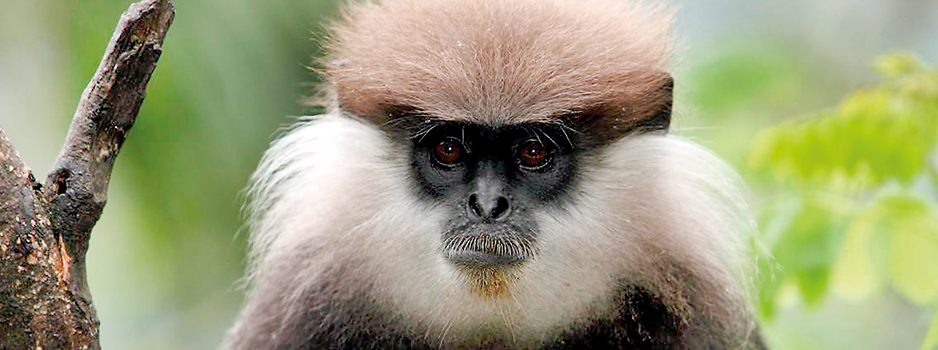Monkey business in all its forms
Being among our closest relatives in the evolutionary tree, monkeys have a special place even in those of us least interested in wildlife. Their facial expressions and farcical behaviours remind us so much of ourselves that it is easy to imagine they are just ‘little people’. Although a formidable body of research has been done on Sri Lanka’s monkeys and lorises (the island’s only primates, to which humans too, should properly be added), little of this information has yet been presented to the general public. This new book, Sri Lankan Primates: An Enthusiasts’ Guide, changes all that.

It is an unusual work that could just as easily pass off as a coffee-table volume thanks to its format and excellent photographs, not just of Sri Lanka’s numerous species and subspecies of primates, but also their relatives in mainland India. Though largely the work of Nadika Hapuarachchi, the illustrations are augmented with images from numerous other local and foreign photographers, making it a truly remarkable volume. Also presented are the results of a national survey of primates executed in the past several years by the Galle Wildlife Conservation Society, led by Madura de Silva.
A well-researched text by Rohan Pethiyagoda summarises just about all that is known about Sri Lanka’s primates. In the Preface the author says he was “prevailed uponů to generate a brief text to accompany the photographs” but, given the 15,000-word text, it is in fact quite comprehensive. A specialist in the study of fish, Pethiyagoda makes no pretence of being an expert on primates, apparently having treated the project as an exercise in science journalism.
Evidently for this reason, the text is cluttered with numerous references to the scientific literature, though he goes to some pains to explain everything in clear language accessible to the layperson, on occasion assisted by his son (Rohan Jr) and Georgina Gemmell, who in addition to being the book’s copy-editor, also co-authored the chapter on conservation.
The book begins with a well-researched and illustrated history of primate studies in Sri Lanka, from the beginnings of the European presence in the island. Few Sri Lankans would know, for example, that William Charles Osman Hill, one of the world’s greatest primatologists (and also the PhD supervisor of Jane Goodall) was domiciled in Sri Lanka, as professor of anatomy at the Colombo Medical College, from 1930-1945. But, as Pethiyagoda explains, while the early researchers focused on taxonomy and anatomy, a far more productive phase in primate studies commenced in the early 1960s with the arrival of Suzanne Ripley, an American PhD student, who commenced her studies of primate sociology at Polonnaruwa in a project funded by the Smithsonian Institution.
With Ripley’s return to America, the project was handed over to Wolfgang Dittus, whose PhD dissertation (1974: University of Maryland) was on the ecology and behaviour of the toque monkeys at the Polonnaruwa study site. In all, as Pethiyagoda explains, Ripley and Dittus initiated in Sri Lanka the world’s longest-running project on the study of primates, now half a century old.
To this day, Dittus’s team has tracked and continues to track the life histories of some 5,000 macaques from birth to death, maintains genealogies, documents migration between troops and monitors the social rank and relations of each individual monkey.
Almost everything that has recently been discovered about the island’s primates is owed to a few individuals who have made this their life’s work: Wolfgang Dittus, Anna Nekaris, Jinie Dela and Saman Gamage, to name perhaps the four most important of them. And it is on their published output that Pethiyagoda draws for his own account.
Given this volume of work, there is almost no aspect of Sri Lanka’s primates that is not covered by the text: their taxonomy, behaviour, sociology, diet, distribution and reproduction, much of this illustrated with excellent colour photographs. The photos include the elusive highland loris, rediscovered by Saman Gamage in 2010 after being thought extinct for almost half a century. In the book, the WCSG team report the subspecies from several additional locations, suggesting that it is perhaps not on the brink of extinction, though its montane-forest habitat is fast disappearing.
Separate chapters are devoted to the history of primatology, lorises, macaques, leaf-monkeys and langurs, finished off with a poignant chapter on conservation that calls for greater public participation in efforts to save these species, two of which are considered Endangered in the IUCN’s Red List.
I strongly recommend Sri Lankan Primates to anyone at all interested not just in the island’s wildlife, but also curious about us humans (in relation to which, for example, Pethiyagoda’s essay ‘Why macaque blokes dig red-faced chicks’ makes interesting reading, especially as he carefully sidesteps drawing comparisons with human females and facial makeup!).
It contains just about everything there is to know about these fascinating mammals, presented succinctly and in easy-to-understand language that avoids unnecessary jargon. It is a book that is a pleasure to recommend and I found little to complain about, though I wish Nadika Hapuarachchi had managed to get a photograph of a macaque diving underwater to feed on water-lilly roots, shown vividly in the BBC documentary on Dittus’s Polonnaruwa macaques, ‘Temple Troop’.
Primatology is a well-established field in Sri Lanka and I hope this book will draw renewed public attention to the need to conserve Sri Lanka’s unique primate fauna while attracting fresh blood into the field, especially in addressing the formidable challenges in conserving a fauna that can teach us so much about ourselves. Madura de Silva and Nadika Hapuarachchi and their team should be congratulated for bringing out this excellent and useful book.
Follow @timesonlinelk
comments powered by Disqus


























